Big news—we're now in Whole Foods! Check out our store locator for more information.

We all love gingerbread during the holiday season, ginger and lemon tea on a cold night, and ginger ale for a queasy stomach — but have you ever wondered about the journey of ginger and how its current state came to be?
Before its prevalence around the globe, ginger first appeared in China. People had deemed this plant root an essential spice and medicine that could contribute to body healing for various ailments. Historically, ginger was one of the first known spices to be traded globally. First to India, then gradually to Europe and other Mediterranean regions (and remember, this is still the 1st century!). As a result of the spice trade, ginger quickly gained its popularity and was widely used by ancient Greeks and Romans. Following the fall of the Roman empire, ginger was unfortunately forgotten by the Europeans until Marco Polo, the famous merchant and explorer, brought it back after traveling to Asia along the Silk Road.
While people nowadays can easily find and afford either fresh or ground ginger in most supermarkets, its price soared in the Middle Ages due to its relative scarcity — a half kilogram (1.1 pounds) of ginger was worth nearly the price of one sheep. Yikes. Thankfully, with the continued expansion of global trade and improved farming efficiency, ginger’s popularity was back again. According to the United Nations, the global production of ginger nearly topped 2.8 million tons in 2018, with India being the largest producer and China the second.
As we trace back to the history of ginger, it’s both surprising and unsurprising how this plant came to be. Surprising due to its ability to withstand challenges throughout time, yet unsurprising, as its reputation for providing various health benefits are passed from generation to generation.
The bottom line is: ginger has been used to prevent and reverse disease for thousands of years in traditional healing systems. Whether you already deem ginger as your kitchen buddy or not, we hope this little retracing of its history would help establish a little more connection. And if ginger is still not your friend, give it a try by adding it to your shopping list. I like sprinkling powdered ginger over sweet potatoes or roasted butternut squash, or simply using it fresh to make lemon ginger tea. It’s also perfect for a weeknight Asian stir fry. Hopefully, this ancient delicious natural ingredient won’t leave you disappointed.

Tong, as we the Cantonese would call broth, is just as essential to any dining table as rice. Usually composed of a protein (chicken, pork, beef, or fish) combined with vegetables, seeds, and medicinal herbs, Tong is served at the beginning of the meal and consumed throughout mealtime as a beverage.


In fact, many microbes carry essential roles in our bodily functions, such as breaking down the food we eat, working alongside our immune system, providing nutrients for other cells in the body, and regulating metabolism. What’s more, our gut microbiome is able to change its composition based on what food we eat. You’ve probably heard those beneficial probiotics in yogurt a thousand times, but what if I tell you those magical microbes are present in many popular Asian foods as well?
Ruby ruby@freshzenfoods.com
Author